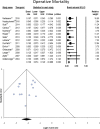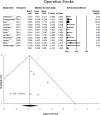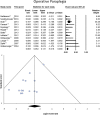Secondary Open Aortic Procedure Following Thoracic Endovascular Aortic Repair: Meta-Analytic State of the Art
- PMID: 28903940
- PMCID: PMC5634303
- DOI: 10.1161/JAHA.117.006618
Secondary Open Aortic Procedure Following Thoracic Endovascular Aortic Repair: Meta-Analytic State of the Art
Abstract
Background: Thoracic endovascular aortic repair is characterized by a substantial need for reintervention. Secondary open aortic procedure becomes necessary when further endoluminal options are exhausted. This synopsis and quantitative analysis of available evidence aims to overcome the limitations of institutional cohort reports on secondary open aortic procedure.
Methods and results: Electronic databases were searched from 1994 to the present date with a prospectively registered protocol. Pooled quantification of pre/intraoperative variables, and proportional meta-analysis with random effect model of early and midterm outcomes were performed. Subgroup analysis was conducted for patients who had early mortality. Fifteen studies were elected for final analysis, encompassing 330 patients. The following values are expressed as "pooled mean, 95% confidence interval." Type B dissection was the most common pathology at index thoracic endovascular aortic repair (51.2%, 44.4-57.9). The most frequent indication for secondary open aortic procedure was endoleak (39.7%, 34.6-45.1). More than half of patients had surgery on the descending aorta (51.2%, 45.8-56.6), and one fourth on the arch (25.2%, 20.8-30.1). Operative mortality was 10.6% (7.4-14.9). Neurological morbidity was substantial between stroke (5.1%, 2.8-9.1) and paraplegia (8.3%, 5.2-13.1). At 2-year follow-up, mortality (20.4%, 11.5-33.5) and aortic adverse event (aortic death 7.7%, 4.3-13.3, tertiary aortic open procedure 7.4%, 4.0-13.2) were not negligible.
Conclusions: In the secondary open aortic procedure population, type B dissection was both the most common pathology and the one associated with the lowest early mortality, whereas aortic infection and extra-anatomical bypass were associated with the most ominous prognosis.
Keywords: aorta; aortic arch; aortic disease; aortic dissection; aortic surgery.
© 2017 The Authors. Published on behalf of the American Heart Association, Inc., by Wiley.
Figures











Similar articles
-
Outcomes of thoracic endovascular aortic repair using aortic arch chimney stents in high-risk patients.J Vasc Surg. 2017 Jul;66(1):9-20.e3. doi: 10.1016/j.jvs.2016.11.063. J Vasc Surg. 2017. PMID: 28216358 Free PMC article.
-
Short- and Long-term Results of Hybrid Arch and Proximal Descending Thoracic Aortic Repair: A Benchmark for New Technologies.J Endovasc Ther. 2016 Oct;23(5):783-90. doi: 10.1177/1526602816655446. Epub 2016 Jun 19. J Endovasc Ther. 2016. PMID: 27324591
-
Single-center experience with an inner branched arch endograft.J Vasc Surg. 2019 Apr;69(4):977-985.e1. doi: 10.1016/j.jvs.2018.07.076. Epub 2018 Nov 23. J Vasc Surg. 2019. PMID: 30477941
-
Systematic review and meta-analysis of acute type B thoracic aortic dissection, open, or endovascular repair.J Vasc Surg. 2019 May;69(5):1599-1609.e2. doi: 10.1016/j.jvs.2018.08.187. Epub 2018 Dec 28. J Vasc Surg. 2019. PMID: 30598351
-
Techniques and outcomes of secondary open repair for chronic dissection after acute repair of type A aortic dissection.J Cardiovasc Surg (Torino). 2018 Dec;59(6):759-766. doi: 10.23736/S0021-9509.18.10646-X. Epub 2018 Jun 26. J Cardiovasc Surg (Torino). 2018. PMID: 29943963 Review.
Cited by
-
Long-Term Outcomes of Open Surgery and Stent Graft Treatment in Patients Undergoing Repeat Thoracic Aortic Aneurysm Repair from Previous Anastomosis Site.Ann Vasc Dis. 2019 Dec 25;12(4):500-506. doi: 10.3400/avd.oa.19-00052. Ann Vasc Dis. 2019. PMID: 31942208 Free PMC article.
-
Are current follow-up intervals justified in patients with non-emergent aortic surgeries?Interdiscip Cardiovasc Thorac Surg. 2024 Dec 25;40(1):ivae226. doi: 10.1093/icvts/ivae226. Interdiscip Cardiovasc Thorac Surg. 2024. PMID: 39731738 Free PMC article.
References
-
- DeBakey ME, Crawford ES, Cooley DA, Morris GC Jr. Successful resection of fusiform aneurysm of aortic arch with replacement by homograft. Surg Gynecol Obstet. 1957;105:657–664. - PubMed
-
- Hiratzka LF, Bakris GL, Beckman JA, Bersin RM, Carr VF, Casey DE Jr, Eagle KA, Hermann LK, Isselbacher EM, Kazerooni EA, Kouchoukos NT, Lytle BW, Milewicz DM, Reich DL, Sen S, Shinn JA, Svensson LG, Williams DM. 2010 ACCF/AHA/AATS/ACR/ASA/SCAI/SIR/STS/SVM guidelines for the diagnosis and management of patients with Thoracic Aortic Disease: a report of the American College of Cardiology Foundation/American Heart Association Task Force on Practice Guidelines, American Association for Thoracic Surgery, American College of Radiology, American Stroke Association, Society of Cardiovascular Anesthesiologists, Society for Cardiovascular Angiography and Interventions, Society of Interventional Radiology, Society of Thoracic Surgeons, and Society for Vascular Medicine. Circulation. 2010;121:266–369. - PubMed
-
- Erbel R, Aboyans V, Boileau C, Bossone E, Bartolomeo RD, Eggebrecht H, Evangelista A, Falk V, Frank H, Gaemperli O, Grabenwöger M, Haverich A, Iung B, Manolis AJ, Meijboom F, Nienaber CA, Roffi M, Rousseau H, Sechtem U, Sirnes PA, Allmen RS, Vrints CJ. 2014 ESC guidelines on the diagnosis and treatment of aortic diseases: document covering acute and chronic aortic diseases of the thoracic and abdominal aorta of the adult. The Task Force for the Diagnosis and Treatment of Aortic Diseases of the European Society of Cardiology (ESC). Eur Heart J. 2014;35:2873–2926. - PubMed
Publication types
MeSH terms
LinkOut - more resources
Full Text Sources
Other Literature Sources
Medical

